A New Fracturing Method to Improve Stimulation Effect of Marl Tight Oil Reservoir in Sichuan Basin
Abstract
:1. Introduction
2. Materials and Methods
3. Results and Discussion
3.1. Optimization of Fracturing Parameters in Tight Marl Reservoir
3.2. Filtration Control Technology of Fracturing Fluid
3.3. Study on the Conductivity and Placement Form of Proppant
3.4. Field Application
4. Conclusions
- (1)
- Mudstone will shield the seepage of oil, and the fracturing of marl horizontal wells needs to ensure perforation in the limestone reservoir. At the same time, numerical simulations have shown that the optimal fracture spacing for fracturing the Sichuan Basin argillaceous limestone reservoir is 80 m.
- (2)
- The 70/140 mesh ceramsite can effectively reduce fracturing fluid loss and is the best fluid loss additive for argillaceous limestone reservoirs in the Sichuan Basin. The fracturing fluid loss of 70/140 mesh ceramides is 43% less than that of 30/50 mesh ceramides.
- (3)
- To increase fracture conductivity and length, a mixture of 70/140 mesh ceramic particles and 40/70 mesh ceramic particles with a mass ratio of 6:4 is recommended as the fracture proppant. The fracture monitoring results of the SC1 well show that the fracture length of the combined ceramite can reach 129 m.
Author Contributions
Funding
Institutional Review Board Statement
Informed Consent Statement
Data Availability Statement
Acknowledgments
Conflicts of Interest
References
- Wang, Y.; Zhou, C.; Yi, X.; Li, L.; Chen, W.; Han, X. Technology and Application of Segmented Temporary Plugging Acid Fracturing in Highly Deviated Wells in Ultradeep Carbonate Reservoirs in Southwest China. ACS Omega 2020, 5, 25009–25015. [Google Scholar] [CrossRef]
- Wang, Y.; Fan, Y.; Zhou, C.; Luo, Z.; Chen, W.; He, T.; Fang, H.; Fu, Y. Research and Application of Segmented Acid Fracturing by Temporary Plugging in Ultradeep Carbonate Reservoirs. ACS Omega 2021, 6, 28620–28629. [Google Scholar] [CrossRef]
- Wang, Y.; Fan, Y.; Wang, T.; Ye, J.; Luo, Z. A New Compound Staged Gelling Acid Fracturing Method for Ultra-Deep Horizontal Wells. Gels 2022, 8, 449. [Google Scholar] [CrossRef]
- Zhang, Q.; Li, M.; Zhang, Z.; Chen, Y.; Zhang, L.; Li, A. Application of volume fracturing technology in tight oil reservoirs of Shengli oilfield. China Pet. Explor. 2019, 24, 233. [Google Scholar]
- Xu, S.; Guo, J.; Feng, Q.; Ren, G.; Li, Y.; Wang, S. Optimization of hydraulic fracturing treatment parameters to maximize economic benefit in tight oil. Fuel 2022, 329, 125329. [Google Scholar] [CrossRef]
- Zhao, X.; Liu, X.; Yang, Z.; Wang, F.; Zhang, Y.; Liu, G.; Lin, W. Experimental study on physical modeling of flow mechanism in volumetric fracturing of tight oil reservoir. Phys. Fluids 2021, 33, 107118. [Google Scholar] [CrossRef]
- Zhang, L.; Li, Z.; Lai, F.; Li, H.; Adenutsi, C.D.; Wang, K.; Yang, S.; Xu, W. Integrated optimization design for horizontal well placement and fracturing in tight oil reservoirs. J. Pet. Sci. Eng. 2019, 178, 82–96. [Google Scholar] [CrossRef]
- Yu, L.; Wang, J.; Wang, C.; Chen, D. Enhanced tight oil recovery by volume fracturing in Chang 7 reservoir: Experimental study and field practice. Energies 2019, 12, 2419. [Google Scholar] [CrossRef]
- Hu, S.; Zhu, R.; Wu, S.; Bai, B.; Yang, Z.; Cui, J. Exploration and development of continental tight oil in China. Pet. Explor. Dev. 2018, 45, 790–802. [Google Scholar] [CrossRef]
- Guo, D.; Kang, Y.; Wang, Z.; Zhao, Y.; Li, S. Optimization of fracturing parameters for tight oil production based on genetic algorithm. Petroleum 2022, 8, 252–263. [Google Scholar] [CrossRef]
- Cai, B.; Zhao, X.; Shen, H.; Zhao, A.; Cai, J.; Wu, G.; Wang, D.; Zhong, X.; Luo, Y. Hybrid stimulated reservoir volume technology for tight oil in Shulu sag. Acta Pet. Sin. 2015, 36, 76. [Google Scholar]
- Luo, Z.; Zhang, N.; Zhao, L.; Liu, F.; Liu, P.; Li, N. Modeling of pressure dissolution, proppant embedment, and the impact on long-term conductivity of propped fractures. J. Pet. Sci. Eng. 2020, 186, 106693. [Google Scholar] [CrossRef]
- Zhang, S.C.; Lei, X.; Zhou, Y.S.; Xu, G.Q. Numerical simulation of hydraulic fracture propagation in tight oil reservoirs by volumetric fracturing. Pet. Sci. 2015, 12, 674–682. [Google Scholar] [CrossRef]
- Zhou, F.; Su, H.; Liang, X.; Meng, L.; Yuan, L.; Li, X.; Liang, T. Integrated hydraulic fracturing techniques to enhance oil recovery from tight rocks. Pet. Explor. Dev. 2019, 46, 1065–1072. [Google Scholar] [CrossRef]
- Xu, J.; Li, J.; Wu, Y.; Ding, K.; Jiang, H. Exploration and practice of volume fracturing technology in horizontal well of Mahu tight conglomerate reservoirs. China Pet. Explor. 2019, 24, 241. [Google Scholar]
- Liu, H.; Luo, Y.; Li, X.; Xu, Y.; Yang, K.; Mu, L.; Zhao, W.; Zhou, S. Advanced completion and fracturing techniques in tight oil reservoirs in ordos basin: A workflow to maximize well potential. In Proceedings of the IPTC 2013: International Petroleum Technology Conference, Beijing, China, 26–28 March 2013; EAGE Publications BV: Utrecht, The Netherlands, 2013. Cp-350-00577. [Google Scholar]
- Jin, C.; Yang, D.; Zhang, Y.; Huo, F.; Gu, M. Optimization techniques for stimulation design of horizontal wells of heterogeneous tight oil in northern Songliao Basin. China Pet. Explor. 2014, 19, 40. [Google Scholar]
- Zhao, H.; Li, W.; Pu, H.; Yang, K. Formation applicability analysis of stimulated reservoir volume fracturing and case analysis. Petroleum 2021, 7, 160–167. [Google Scholar] [CrossRef]
- Ce, W.; Shanbin, H.; Mingyu, W.; Fafeng, X. Density cutting volume fracturing technology for horizontal wells in the ultra-low permeability reservoirs: A case study of the Yuan284 area in the Huaqing oilfield Ordos Basin, China. Arab. J. Geosci. 2022, 15, 1409. [Google Scholar] [CrossRef]
- Bazan, L.W.; Larkin, S.D.; Lattibeaudiere, M.G.; Palisch, T.T. Improving production in the Eagle Ford shale with fracture modeling, increased conductivity and optimized stage and cluster spacing along the horizontal wellbore. In Proceedings of the Tight Gas Completions Conference, San Antonio, TX, USA, 2–3 November 2010; OnePetro: Richardson, TX, USA, 2010. [Google Scholar]
- Shirbazo, A.; Fahimpour, J.; Aminshahidy, B. A new approach to finding effective parameters controlling the performance of multi-stage fractured horizontal wells in low-permeability heavy-oil reservoirs using RSM technique. J. Pet. Explor. Prod. Technol. 2020, 10, 3569–3586. [Google Scholar] [CrossRef]
- Deng, H.; Sheng, G.; Zhao, H.; Meng, F.; Zhang, H.; Ma, J.; Gong, J.; Ruan, J. Integrated optimization of fracture parameters for subdivision cutting fractured horizontal wells in shale oil reservoirs. J. Pet. Sci. Eng. 2022, 212, 110205. [Google Scholar] [CrossRef]
- Peshcherenko, A.; Bekerov, I.; Chuprakov, D.; Abdrazakov, D. Fast-running model for high-volume hydraulic fracturing. J. Pet. Sci. Eng. 2022, 213, 110430. [Google Scholar] [CrossRef]
- Al-Fatlawi, O.; Hossain, M.; Essa, A. Optimization of fracture parameters for hydraulic fractured horizontal well in a heterogeneous tight reservoir: An equivalent homogeneous modelling approach. In Proceedings of the SPE Kuwait Oil & Gas Show and Conference, Mishref, Kuwait, 13–16 October 2019; OnePetro: Richardson, TX, USA, 2019. [Google Scholar]
- Wang, D.; Dong, Y.; Sun, D.; Yu, B. A three-dimensional numerical study of hydraulic fracturing with degradable diverting materials via CZM-based FEM. Eng. Fract. Mech. 2020, 237, 107251. [Google Scholar] [CrossRef]
- Li, J.; Kuang, S.; Qi, Z.; Liu, P.; Yu, A. Experimental investigation of the leak-off effect on proppant transportation and distribution in a vertical fracture. J. Nat. Gas Sci. Eng. 2022, 97, 104358. [Google Scholar] [CrossRef]
- Telmadarreie, A.; Li, S.; Bryant, S. Effective pressure maintenance and fluid leak-off management using nanoparticle-based foam. In Proceedings of the SPE Canadian Energy Technology Conference, Calgary, AB, Canada, 16–17 March 2022; OnePetro: Richardson, TX, USA, 2022. [Google Scholar]
- Zhong, Y.; Zhang, H.; Zhang, J. Design and development of CaCO3 nanoparticles enhanced fracturing fluids for effective control of leak-off during hydraulic fracturing of shale reservoirs. Nanotechnology 2021, 32, 375401. [Google Scholar] [CrossRef] [PubMed]
- Zou, J.; Jiao, Y.-Y.; Tan, F.; Lv, J.; Zhang, Q. Complex hydraulic-fracture-network propagation in a naturally fractured reservoir. Comput. Geotech. 2021, 135, 104165. [Google Scholar] [CrossRef]
- Wang, D.; Qin, H.; Zheng, C.; Sun, D.; Yu, B. Transport mechanism of temporary plugging agent in complex fractures of hot dry rock: A numerical study. Geothermics 2023, 111, 102714. [Google Scholar] [CrossRef]
- Mayur, P.; Sandip, J. An efficient workflow for meshing large scale discrete fracture networks for solving subsurface flow problems. Pet. Sci. Technol. 2022, 40, 1945–1978. [Google Scholar]
- Yu, C.; Wei, S.; Zhang, Y.; Zheng, Y.; Yu, Z.; Donahoe, R.; Wei, H. Quantifying colloid fate and transport through dense vegetation and soil systems using a particle-plugging tempered fractional-derivative model. J. Contam. Hydrol. 2019, 224, 103484.1–103484.7. [Google Scholar] [CrossRef]
- Leng, J.; Wei, M.; Bai, B. Review of transport mechanisms and numerical simulation studies of preformed particle gel for conformance control. J. Pet. Sci. Eng. 2021, 206, 109051. [Google Scholar] [CrossRef]
- Shi, X.; Zhang, W.; Xu, H.; Xiao, C.; Jiang, S. Experimental study of hydraulic fracture initiation and propagation in unconsolidated sand with the injection of temporary plugging agent. J. Pet. Sci. Eng. 2019, 190, 106813. [Google Scholar] [CrossRef]
- Hu, M.; Hu, Z.; Wei, G.; Yang, W.; Liu, M. Sequence lithofacies paleogeography and reservoir potential of the Maokou formation in Sichuan Basin. Pet. Explor. Dev. 2012, 39, 51–61. [Google Scholar] [CrossRef]
- Jiang, Q.; Wang, W.; Lyu, Q. Characteristics and Controlling Factors of Tight Marl Reservoirs with an Eyelid-Shaped Structure of the First Member of the Deep Maokou Formation in Eastern Sichuan. Energies 2023, 16, 2353. [Google Scholar] [CrossRef]
- Wang, Y.; Lv, Z. Composite stimulation technology for improving fracture length and conductivity of unconventional reservoirs. Front. Phys. 2023, 11, 1181302. [Google Scholar] [CrossRef]
- Cao, P.; Dai, C.; Ma, H.; Yan, X.; Chang, S. Influence of low-permeability layers on remaining oil distribution in dolomite reservoir. J. Southwest Pet. Univ. 2017, 39, 143–154. [Google Scholar]
- Wang, Y.; Fan, Y.; Chen, W. Study and application of temporary plugging agent for temporary plugging acid fracturing in ultra-deep wells of Penglai gas field. Front. Phys. 2023, 11, 257. [Google Scholar] [CrossRef]
- Yang, Y.; Yang, J.; Yang, G.; Tao, S.; NI, C.; Zhang, B.; He, X.; Lin, J.; Huang, D.; Liu, M.; et al. New research progress of Jurassic tight oil in central Sichuan Basin, SW China. Pet. Explor. Dev. Online 2016, 43, 954–964. [Google Scholar] [CrossRef]
- Zhao, L.; Ren, D.; Luo, Z.; Hu, G.; Xiong, Z. A Study on Fracturing Fluid Leak-off in Naturally-fractured Reservoirs. J. Southwest Pet. Univ. 2014, 36, 142. [Google Scholar]
- Katende, A.; Allen, C.; Rutqvist, J.; Nakagawa, S.; Radonjic, M. Experimental and numerical investigation of proppant embedment and conductivity reduction within a fracture in the Caney Shale, Southern Oklahoma, USA. Fuel 2023, 341, 127571. [Google Scholar] [CrossRef]
- Hu, P.; Geng, S.; Liu, X.; Li, C.; Zhu, R.; He, X. A three-dimensional numerical pressure transient analysis model for fractured horizontal wells in shale gas reservoirs. J. Hydrol. 2023, 620, 129545. [Google Scholar] [CrossRef]
- Geng, S.; Li, C.; Li, Y.; Zhai, S.; Xu, T.; Gong, Y.; Jing, M. Pressure transient analysis for multi-stage fractured horizontal wells considering threshold pressure gradient and stress sensitivity in tight sandstone gas reservoirs. Gas Sci. Eng. 2023, 116, 205030. [Google Scholar] [CrossRef]


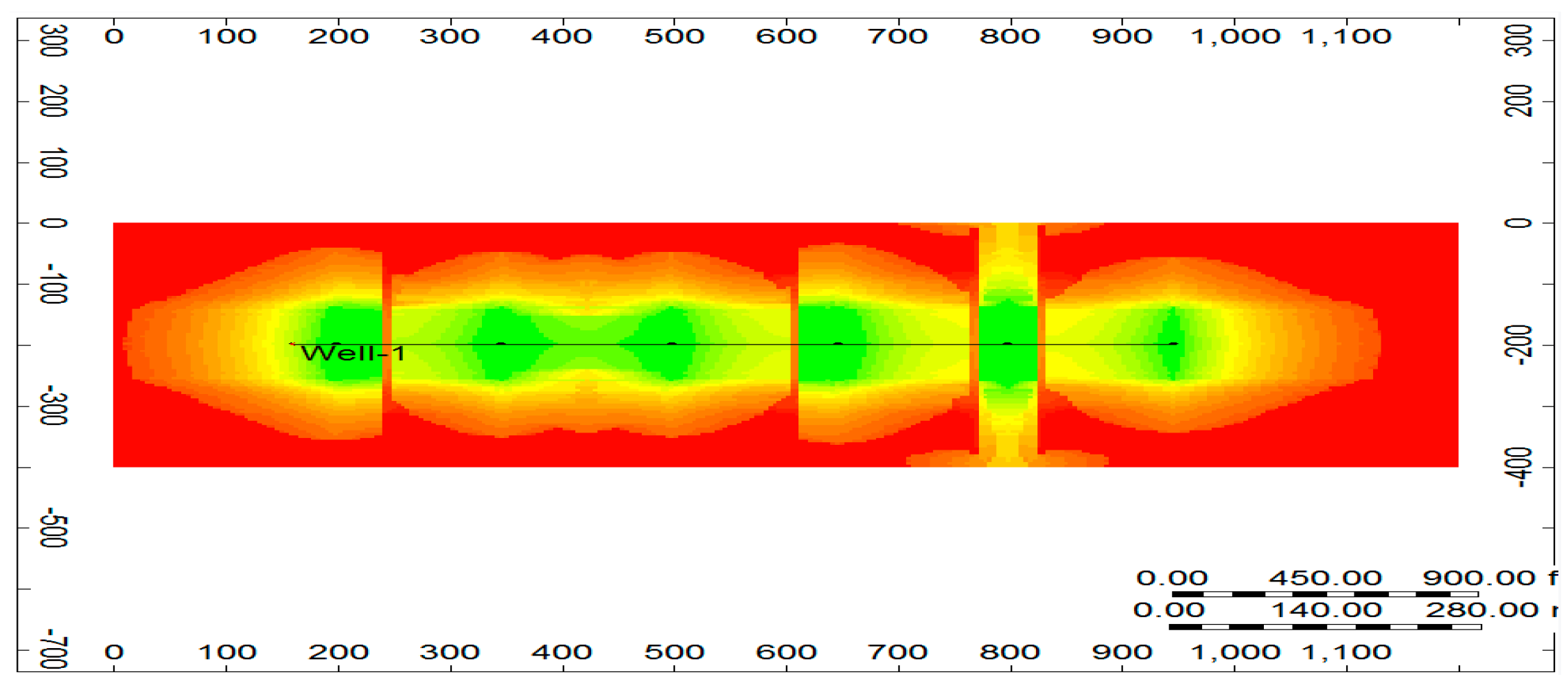
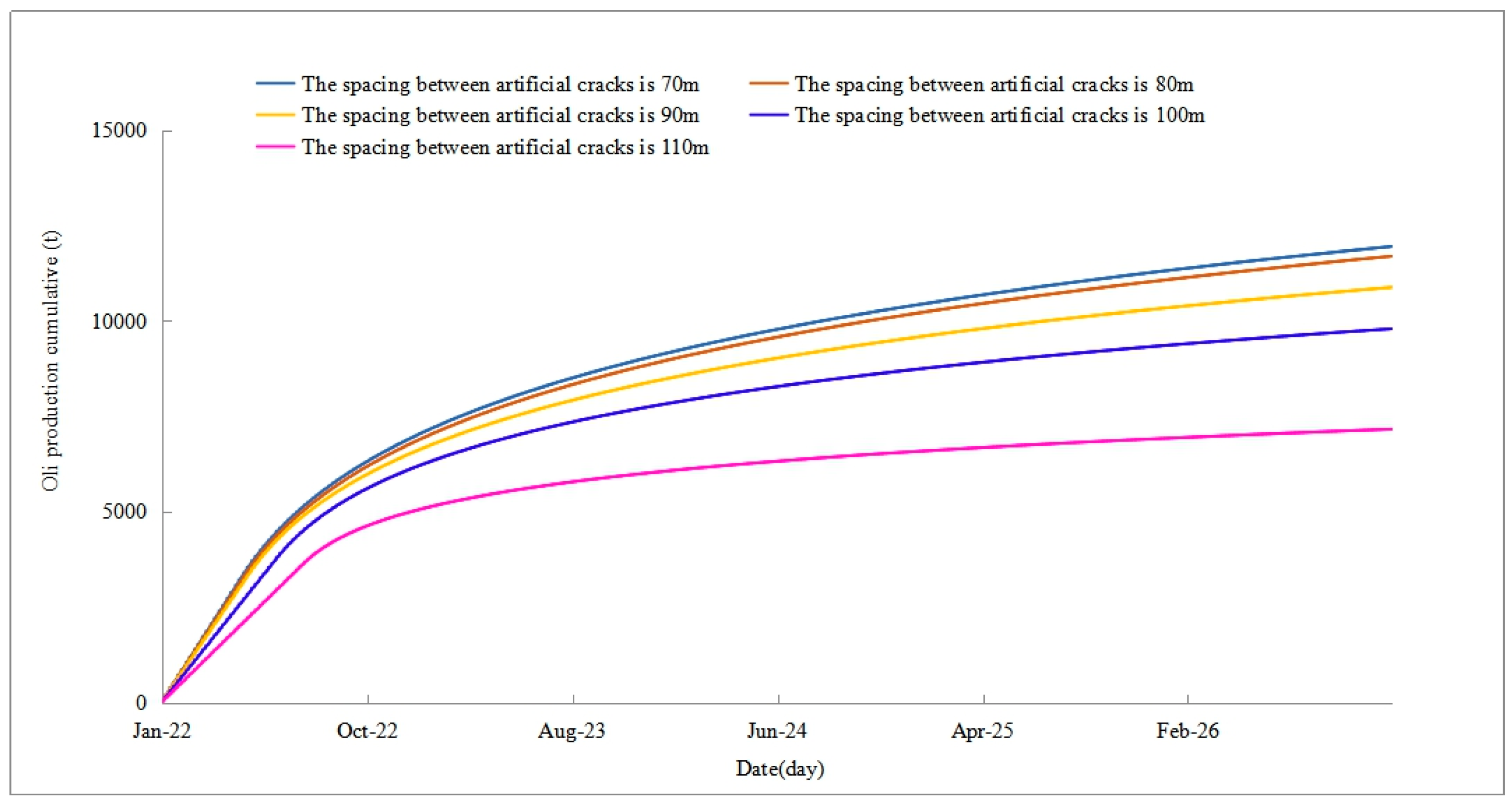
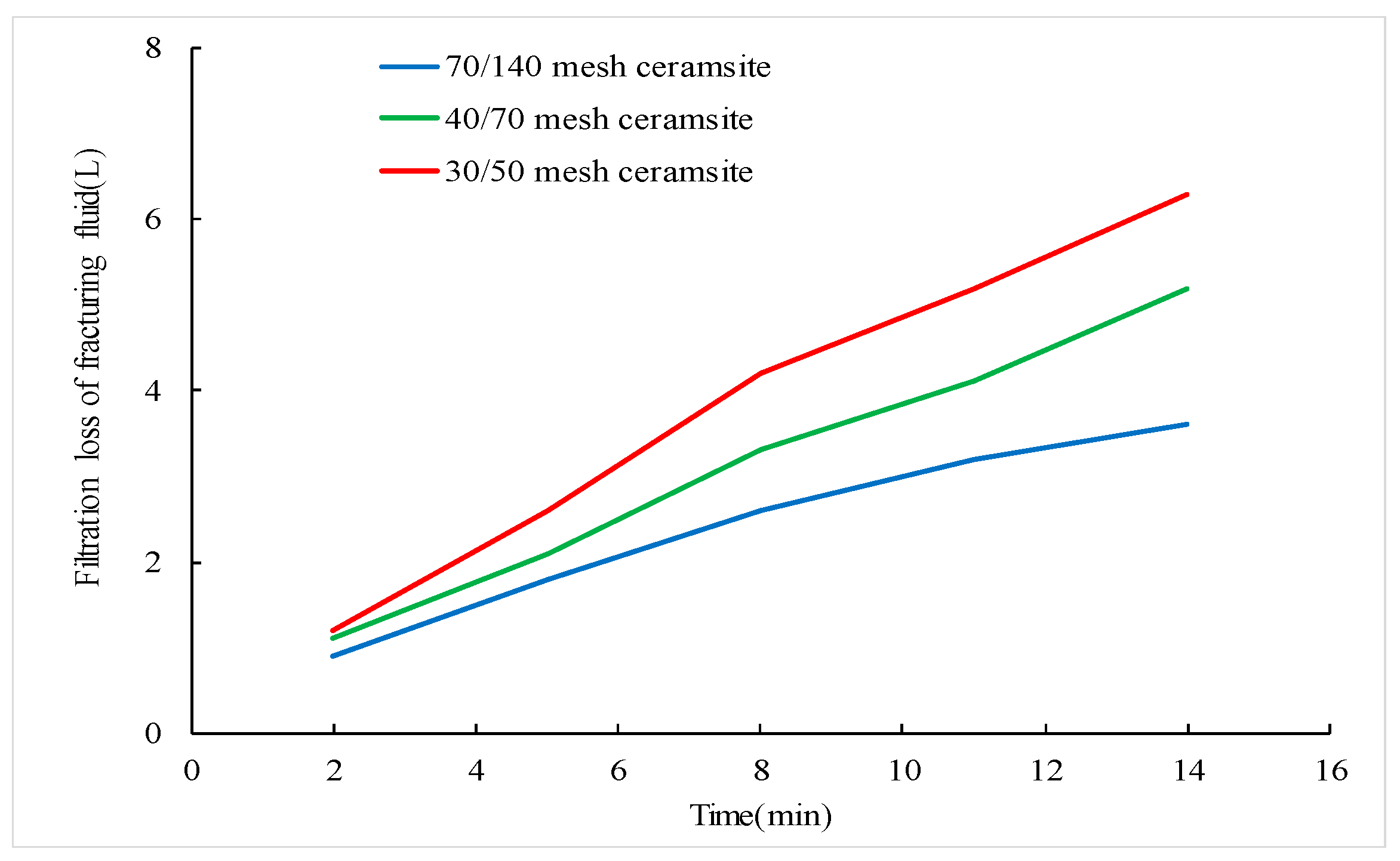
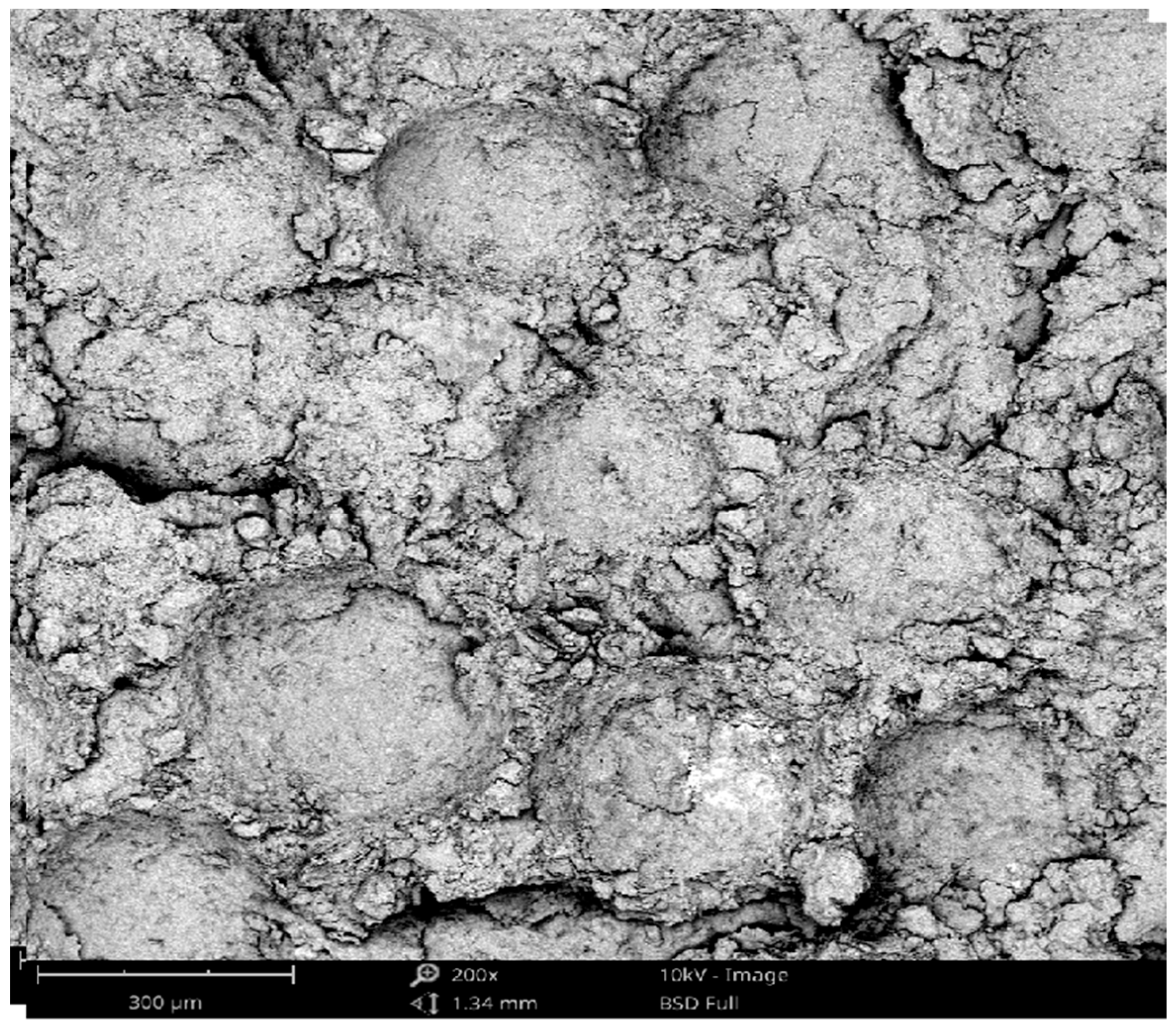
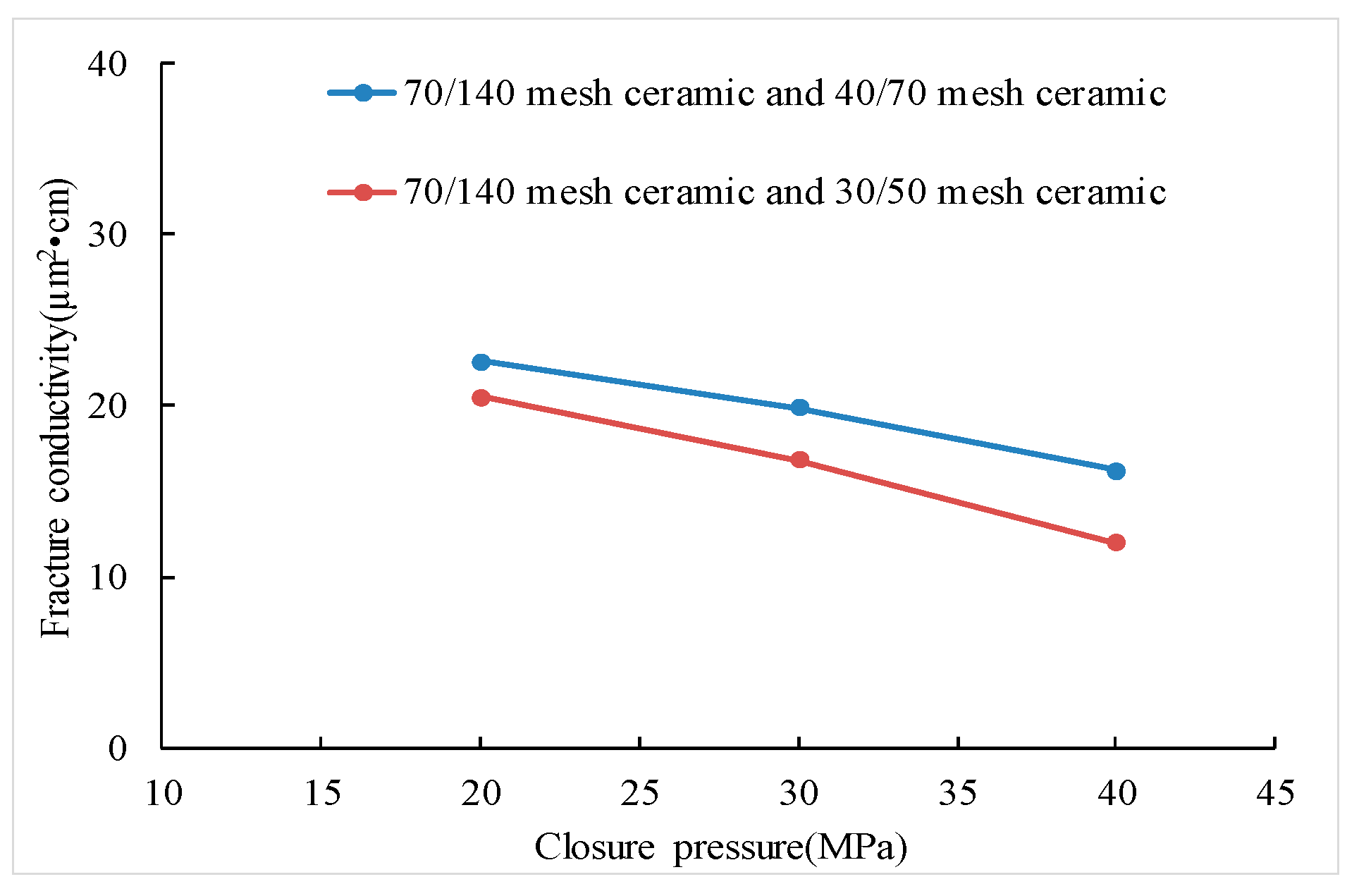

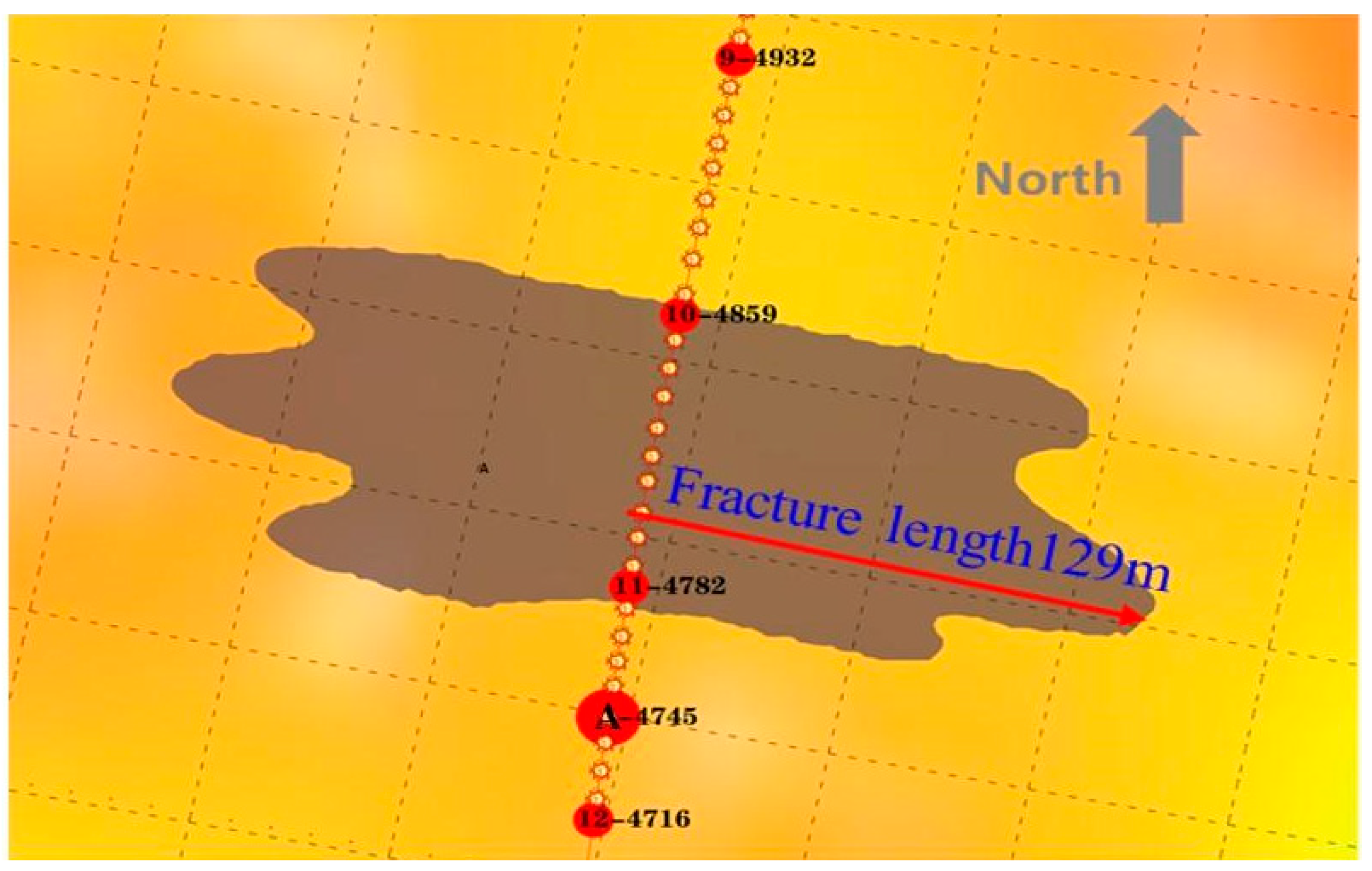
| Proppant | Closure Pressure/MPa | Insertion Depth/mm |
|---|---|---|
| 70/140 mesh ceramsite | 30 | 0.0118–0.0294 |
| 40/70 mesh ceramsite | 0.0336–0.0727 | |
| 30/50 mesh ceramsite | 0.0587–0.0986 |
Disclaimer/Publisher’s Note: The statements, opinions and data contained in all publications are solely those of the individual author(s) and contributor(s) and not of MDPI and/or the editor(s). MDPI and/or the editor(s) disclaim responsibility for any injury to people or property resulting from any ideas, methods, instructions or products referred to in the content. |
© 2023 by the authors. Licensee MDPI, Basel, Switzerland. This article is an open access article distributed under the terms and conditions of the Creative Commons Attribution (CC BY) license (https://creativecommons.org/licenses/by/4.0/).
Share and Cite
Wang, Y.; Fan, Y.; Li, S.; Lv, Z.; He, R.; Wang, L. A New Fracturing Method to Improve Stimulation Effect of Marl Tight Oil Reservoir in Sichuan Basin. Processes 2023, 11, 3234. https://doi.org/10.3390/pr11113234
Wang Y, Fan Y, Li S, Lv Z, He R, Wang L. A New Fracturing Method to Improve Stimulation Effect of Marl Tight Oil Reservoir in Sichuan Basin. Processes. 2023; 11(11):3234. https://doi.org/10.3390/pr11113234
Chicago/Turabian StyleWang, Yang, Yu Fan, Song Li, Zefei Lv, Rui He, and Liang Wang. 2023. "A New Fracturing Method to Improve Stimulation Effect of Marl Tight Oil Reservoir in Sichuan Basin" Processes 11, no. 11: 3234. https://doi.org/10.3390/pr11113234





